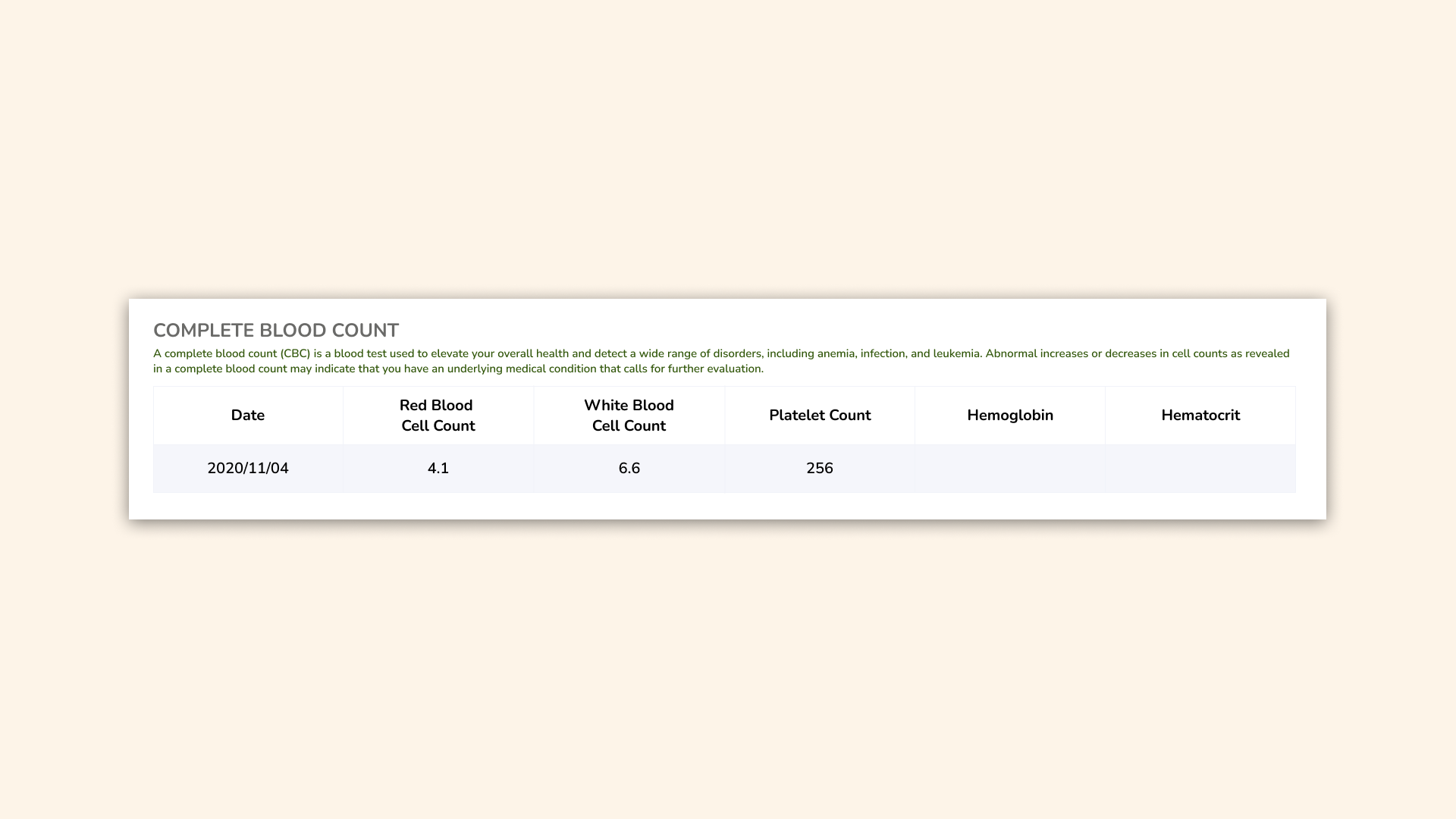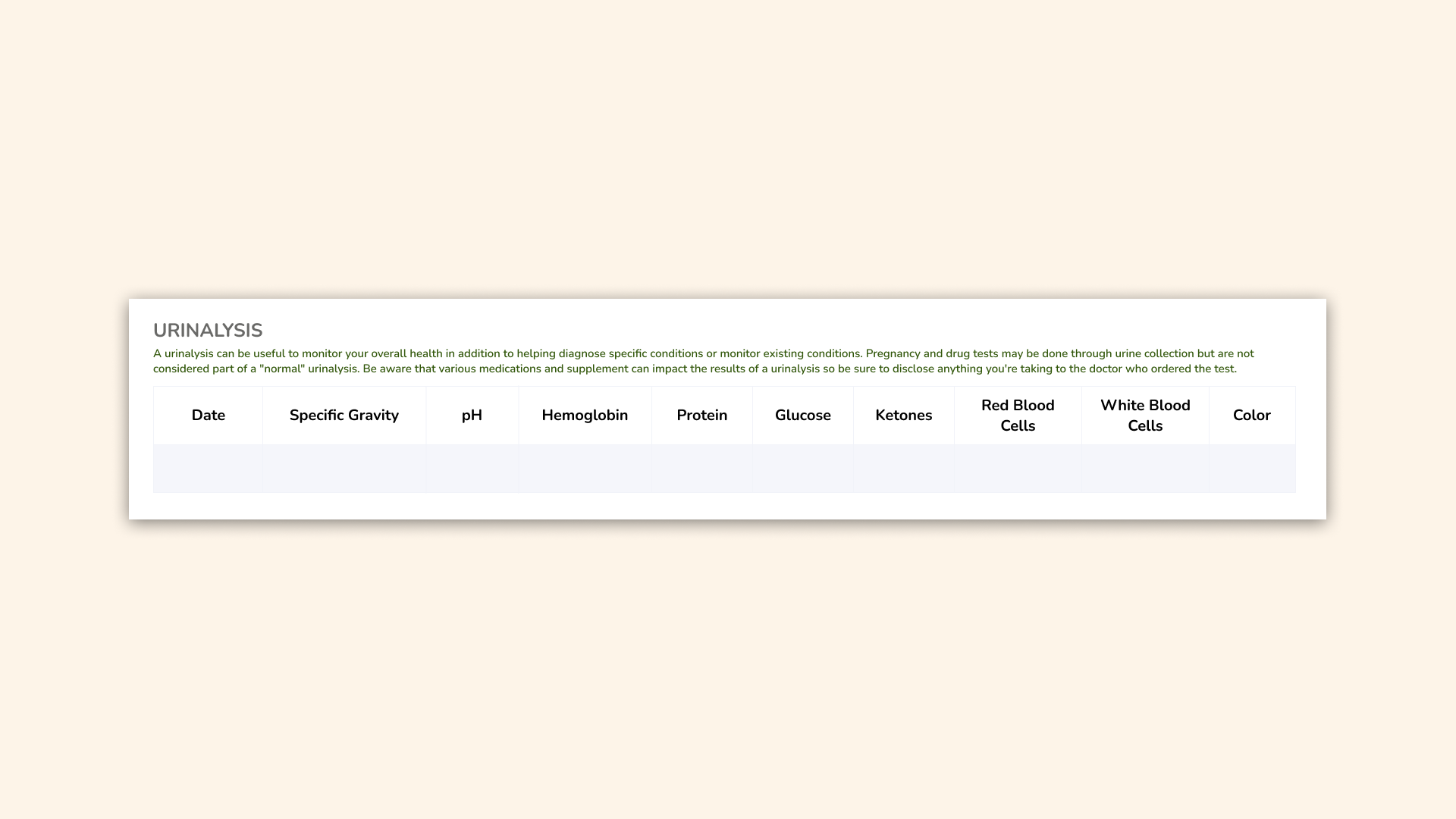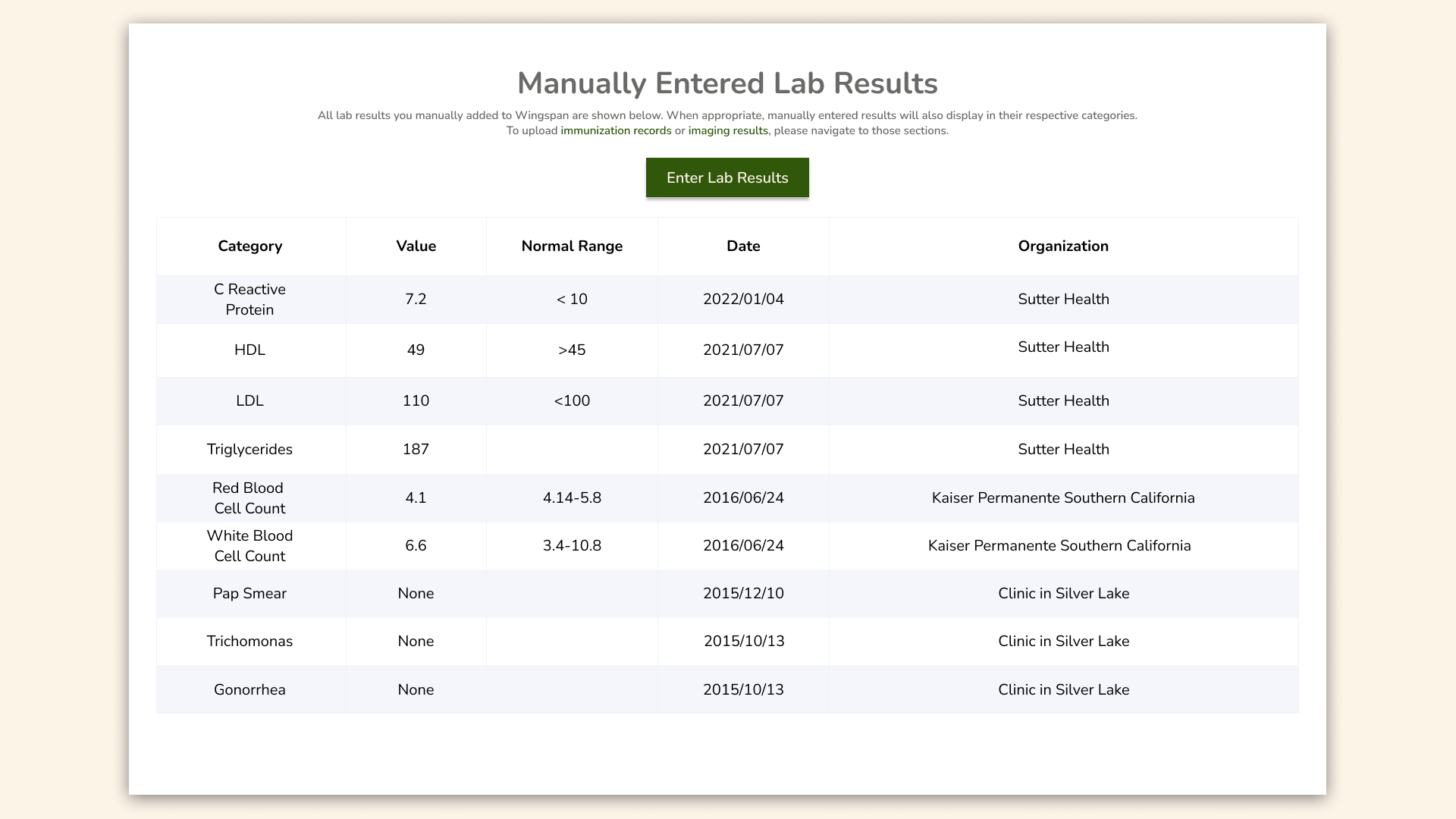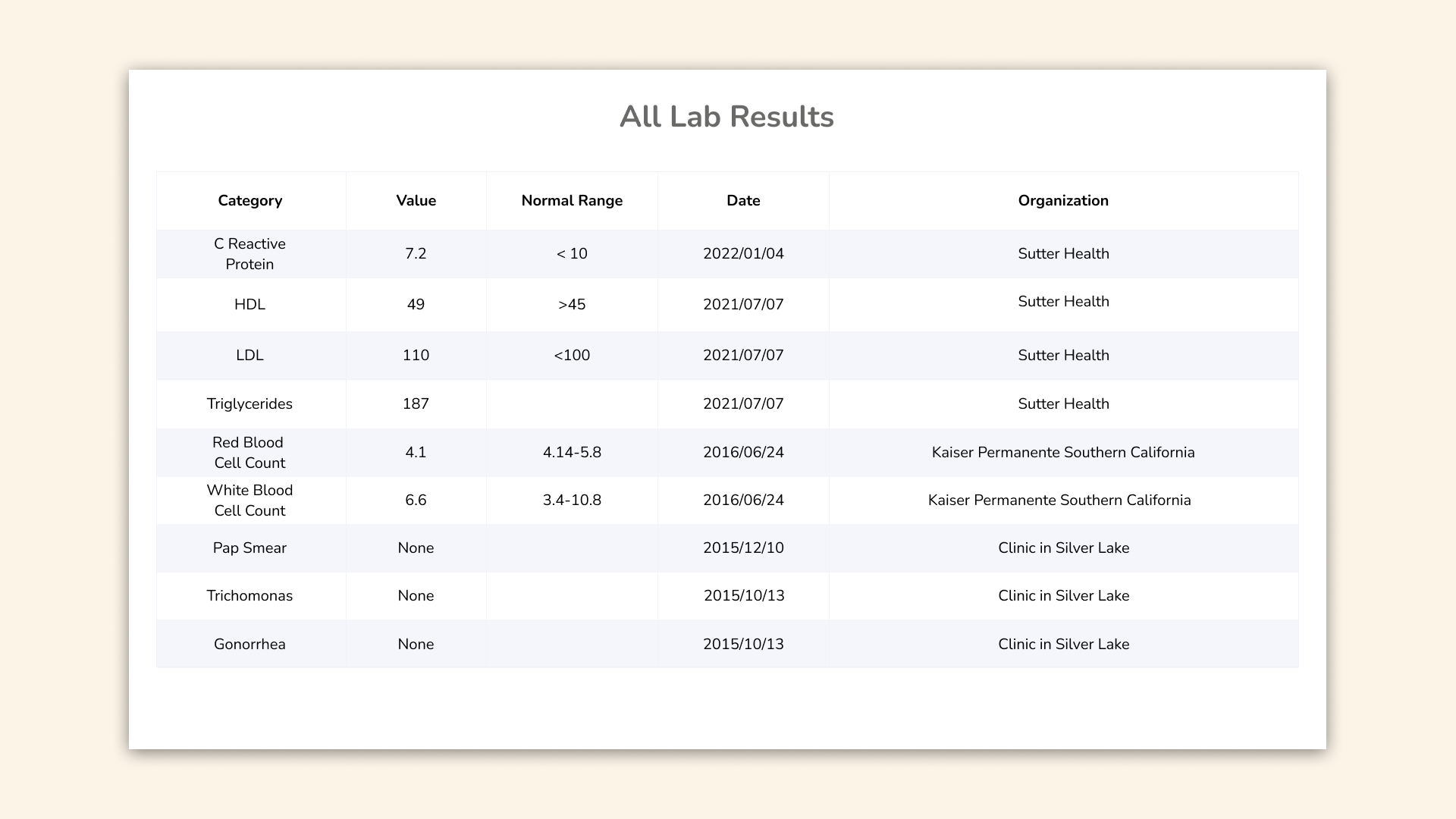How to View Test Results in Wingspan Health
What is the Test Results feature in Wingspan Health?
The Test Results feature in Wingspan Health turns your labs into structured, searchable data – letting you see all your lab results, organized over time and by category. Plus, it adds data from new records if you get another patient portal.
How does the Test Results feature in Wingspan Health work?
After adding patient portals in your Wingspan account from your healthcare providers, Wingspan pulls all of your medical information from your health records related to lab and test results and summarizes it neatly in the Test Results feature.
Feel free to chat with us if you have any questions about this feature in the Wingspan app when you sign in or at hello@wingspanhealth.com!
Now, we’ll break down how each section of the Test Results feature works.
Cardiac
Cholesterol Test Results
In this section, you can see your cholesterol over time in an organized table. Hovering over different parts of the table will define what certain metrics are or normal ranges for values.
LDL: higher levels of LDL raise your risk of heart disease (normal range: <112)
HDL: helps clear out LDL, reducing risk of heart disease (normal range: >45)
Triglycerides: an indicator of fat in the blood, high triglyceride levels are associated with several health conditions. (normal range: <115)
Total Cholesterol: total count of ‘good’ and ‘bad’ cholesterol, the breakdown of HDL & LDL are more important than total count (normal range: <200)
Ratio: total count of ‘good’ and ‘bad’ cholesterol, the breakdown of HDL & LDL are more important than total count
Other Cardiac Blood Tests
In this section, you can see other cardiac blood tests over time in an organized table. Hovering over different parts of the table will define what certain metrics are or normal ranges for values.
C-Reactive Protein: protein the liver makes as part of the body's response to injury or infection, an hs-CRP level above 2.0 mg/L indicates a higher risk of heart disease (normal range: < 2.0 mg/L)
Brain Natriuretic Peptide: protein that the heart and blood vessels make to help the body eliminate fluids, relaxing blood vessels and moves sodium into the urine.
Plasma Ceramides: produced by all cells and play a significant role in the growth, function and ultimately death of many types of tissue, high levels of these ceramides in the blood are a sign of a higher risk of cardiovascular disease.
General Health
Complete Blood Count
A complete blood count (CBC) is a blood test used to evaluate your overall health and detect a wide range of disorders, including anemia, infection and leukemia. Abnormal increases or decreases in cell counts as revealed in a complete blood count may indicate that you have an underlying medical condition that calls for further evaluation.
Red Blood Cell Count: cells that carry oxygen (normal range: see on Mayo Clinic)
White Blood Cell Count: cells that fight infection (normal range: see on Mayo Clinic)
Platelet Count: help with blood clotting (normal range: see on Mayo Clinic)
Hemoglobin: oxygen-carrying protein in red blood cells (normal range: see on Mayo Clinic)
Hematocrit: proportion of red blood cells to the plasma in your blood (normal range: see on Mayo Clinic)
Electrolytes
Electrolytes could be measured via blood test or urinalysis. Indicative of whether or not your body has enough of a given compound, or if it is properly regulating that compound.
Metabolic Counts
Metabolic Counts could be measured via blood test or urinalysis. Indicative of whether or not your body has enough of a given compound, or if it is properly regulating that compound. Contact your doctor for additional information on out of range values.
Liver and Kidney
Substances in your blood can help your doctor determine if you have heart failure or are at risk of developing plaque deposits in your arteries (atherosclerosis). It's important to remember that one blood test alone doesn't determine your risk of heart disease. The most important risk factors for heart disease are smoking, high blood pressure, high cholesterol and diabetes.
Urinalysis
A urinalysis can be useful to monitor your overall health in addition to helping diagnose specific conditions or monitor existing conditions. Pregnancy and drug tests may be done through urine collection but are not considered part of a "normal" urinalysis. Be aware that various medications and supplements can impact the results of a urinalysis so be sure to disclose anything you're taking to the doctor who ordered the test.
Sexual & Hormonal
Thyroid
If the levels of thyroid-related hormones in the blood are too high or too low, there is an imbalance between the amount of thyroid hormones needed by the body and the amount of thyroid hormones available. Often TSH is tested first, while T3 and T4 tests are only run if TSH is abnormal.
Sex Hormones
While these hormones are related to sex characteristics, all people need some level of each of these hormones.
Pap Smear
Adults with normal risk for cervical cancer should have a Pap Smear (aka Pap Test) every 3 years.
Sexual Health
Test results related to common sexually transmitted diseases and infections. See All Results page for additional details or results.
Specialized Screenings
Cancer Screening
Results that are specific to cancer screenings. These results do not cover all potential indicators of cancer.
Manually Entered Labs
Here you can manually enter lab results that are not from your patient portals like from physical paper copies. All lab results you manually added to Wingspan are shown in this section, and are included with the data from your patient portals in the other sections.
How to add a lab result in Wingspan Health:
Click the Enter Lab Results button.
Fill in the following information
Where are these results from? (*required)
When were these results taken?
Add Numeric Result with Name (*required), Value, Unit, and Normal Range) OR Add Positive/Negative Result with Name (*required) and Value Source (*required – Present or Not Present)
How to upload a supporting lab document in Wingspan Health:
Click the Upload Document button at the bottom of the page
Add a description of the document
Choose a file to upload (*required)
Click Upload
All Results
The All Results data display gives you a list of all of the recorded values for each of the aforementioned test results from all of your visits to your healthcare provider and manually entered labs.
The All Results data display is broken down by what was measured (Category), how much was measured (Value), what the normal range is (Normal Range), when it was measured (Date), and where the data came from (Organization).
About Wingspan Health
Wingspan Health is a healthcare technology company that believes that quality healthcare should be accessible for everyone.
Our tool, Wingspan, helps you manage your healthcare by bringing all of your health records in one place – any patient portal account from each of your healthcare providers.
You May Also Like
Explore these other posts to learn more about healthcare, medical information, and Wingspan Health.


















